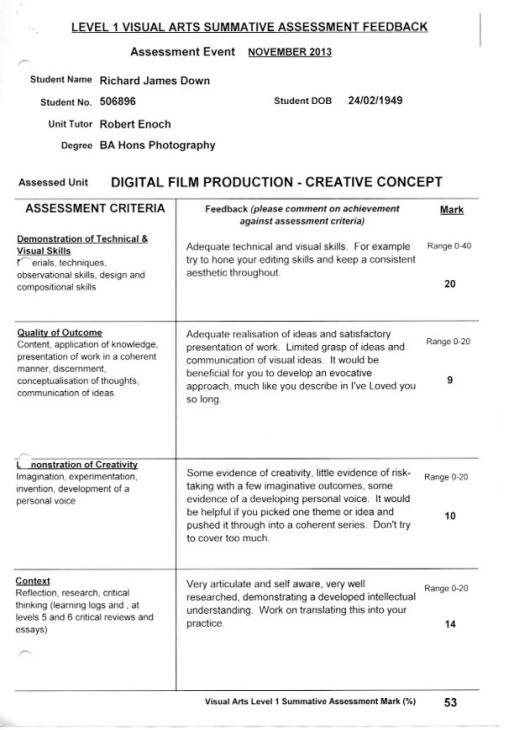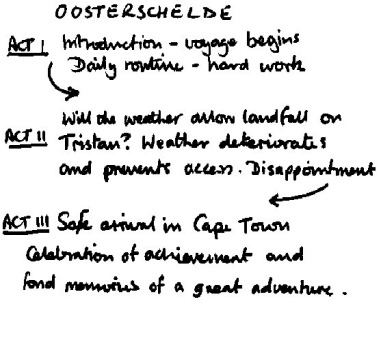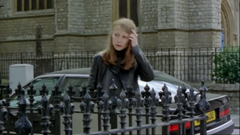Notes on the shooting and editing process: The process of planning this final assignment will be long and complex. I have decided to make notes of the process to give and idea of how it is progressing.
Introduction: I have chosen to use the historic Dutch three masted topsail schooner Oosterschelde as the location for my documentary narrative. I have filmed life on board over a one month period from 1 April to 1 May 2013. These are the notes that I made on board to give myself a skeleton on which to hang my story:
10 April 2013 Tell story with voice over narration from crew members? Three threads:
- Thoughts on the ship, have they been before? What are their impressions?
- Arrival and experience of Tristan da Cunha
- Anticipation and arrival at Cape Town. How was their overall experience?
Record interview to camera, preferably outside with off camera mic. Start on camera and cut to voice over of activities over the voyage. Short questions, encourage narrative answers that can be edited easily into short chunks. Ask fellow watch members to help and others to fill in i.e. Permanent crew, other watches.
(external mic cable broken so rely on on camera mic and audio editing) Example script: 1. Please tell me your name and why you are making this trip, whether or not this your first voyage and your impressions of the Oosterschelde. 2. We are about to, have just or are unable to visit TdC. How did you like the island? How disappointed are you that we were not able to visit? 3. Now we have reached/are nearly at Cape Town, have you enjoyed your voyage? What was the highlight of the experience for you? Will you return to the ship for future trips? 4. Ask Alice to talk about her project on making the anchor bell cover to go over the footage I have. Include a final shot of it at the end of the film. Inter-cut the to camera interviews with footage that includes the speaker, shows time passing or general fill in shots. De- edit the Oosterschelde promo videos for ideas on narrative. Tips from 'Documentary Storytelling':
- Write an outline to plan and diagnose.
- Sequences, like chapters in a book, should feel complete within themselves. Use to help in the editing process.
- How many? 20 minute film about 5 or 6.
Who's on board?
Crew
- Capt. Floris
- First mate. Maarten
- Engineer. Jana
- Cook. Wouter
- Boatmen. Peter, Jakob
- Trainee.Yorick
- Film maker. Daniel
Guests:
Red watch:
| White watch:
| Blue Watch:
|
15 May 2013
Back at home I have reviewed the footage I shot on board. I am now making notes on the sequences I need to tell the story of the voyage from Santos in Brazil to Cape Town in South Africa via Tristan de Cunha. I need to include a lot of the daily activities on board, the interaction of the crew members and trainees. This will give me the feeling of the “place” and what it is like to be part of a small community over an extended period.
My first thought on the narrative is to introduce the vessel as she leaves Santos, show the interviews with Alice, Jan and maybe Simon (may need sub titles as his English is not that easy to understand) As they talk of their experiences and feelings, edit the daily activities under their narration. The anti-climax of not going ashore at Tristan can be a turning point and the anticipation of the arrival in Cape Town. I will proceed on that basis but remain open to other themes that may emerge as I go on.
I am also continuing to learn about my video and audio editing software and will include notes about this.
Rough Edit Notes:
Introductory sequence – put together shore based footage up to the point the boat is off Santos on the first day followed by footage shot during departure.
Second sequence – introduce crew interaction and training function – safety brief?.
(Card 01-0042) voice under clips of sails as they are named by Peter.
Third sequence – First (maybe only) interview/statement – construct subsequent sequences over the dialogue. Interviews:
Jan: Card 01-0053, Alice: -0054, Simon –0055 edit carefully, cut similar ideas and look for clips to go under their selected individual comments.
(
At this point I started looking at the time code, realised I didn’t really understand it and found this reference on Wiki: http://en.wikipedia.org/wiki/SMPTE_timecode ) The final figure after the semi-colon is the frame number i.e. ;1 – 29, further complicated by Drop Time Code, video at 29.97 fps using the media frame rate as default for this application)
The deadline for the submission of my final assignment is here and I will summarise my editing process over the past few weeks.
I met up with Robert my tutor at the Genesis exhibition and I asked him how long the documentary film should be. He told me to aim for 10 minutes (a comfortable length for the assessment process) and to let him look at what I had done before my final edit. With over 40Gb of HD video to process, I had an awful lot of footage to work through and to condense a 31 day voyage into 10 minutes.
I had worked out a basic three act scenario for my narrative and wanted to include most of the routine things that happened on board, introducing the ship and the crew and their motivation, the tension in the decision on whether it was possible to go ashore at Tristan da Cunha and the resolution of the safe arrival in Cape Town and the celebration of a unique achievement as a climax to the story.
A lot of what I had planned was excluded and when I got the rough edit down to 12 minutes I let Robert see it and asked him about the use of sub titles, title cards and the level of finish expected for the final submission. He advised me on these matters and asked me to attend to the sound volume which should hover around –12Db and not go above –6.0Db.
At the same time I showed the rough edit to the Thames Valley Study group and got some good feedback about the use of narrators. The thought Simon Pelikan’s sequence was good as he was more than just a talking head. I cut one of the narrators out and reduced the time that Alice was on the screen as a talking head to just two in the final sequence which sums up her experience of the voyage. I also had a comment about the pace of my editing, it seemed that half way through, the shots became longer and it was felt I had run out of steam. As I was matching the shots to the narration, I quickly improved my skills in the sound editor and cut out a lot of pauses and repetitions which enabled me to tighten the whole thing up. Comment was also made about the camera movement and without any prompting from me, several of the group agreed that this gave a realism and immediacy to the film.
Evaluation: This was a challenging assignment, not only because of the unpredictable conditions under which it was executed but also because of the sheer volume and variety of material that I shot during the five week trip.
I chose the “location” because I would have recorded my trip in any case. This was my second voyage on the Oosterschelde and my second project for OCA, the first being a photo essay I submitted for The Art of Photography course. I was already familiar with the ship, I knew what there was to film and I was sure I could capture the character of the place, who was there and what happened on a daily basis which provided the pace and rhythm. I feel that I have managed to capture all of this by recording the daily activities of the crew as they went about their lives, restricted physically in a space 50m long and 7.5m wide over 31 days.
The narrative was easy to find. The voyage has a beginning a middle and an end. (see above) The tension existed right from the start as it is only possible to go ashore on Tristan on average 100 days a year so there was uncertainty right up until the morning we departed from Tristan waters. I didn’t make a shot list, I knew I had to be ready with my camera at any time but even then, seasickness, sleep and a 24 hour constantly rotating watch system meant that there was a lot I didn’t see. I planned to use the three other members of my watch to tell the story but Alice was the only member who was able to be interviewed three times.
Having lived with my project constantly for the past weeks I’m not sure I can be objective. there is a lot I like about the film, some things I am not sure about. Bringing the film down to 10 minutes (and 23 seconds with the titles and credits) was hard. I took out a lot including one interview which was purely conversational and added nothing to the narrative. I am happy with the background music, it provides a certain movement and carries the film forward at a suitable pace. Wind noise was a constant problem. I misplaced the lead for my external microphone which has a decent wind baffle so I have had to rely on audio restoration software to reduce it. The constant sound and movement are features of life on board so I have left the sounds in at a much reduced level. There are places where the visual quality is lacking, below decks in particular was poorly lit. I had an LED array lamp but it had a restricted range. Filming at dusk and dawn had its problems too. I’m hoping that even within the limits of the available equipment I have managed to put together an interesting and engaging film. I learned a lot about recognising narrative from this assignment. I hope to be able to put this to use in other courses that I undertake as I work towards my degree.
Crossing the Atlantic - Three Masted Topsail Schooner Oosterschelde - April 2013 from
Richard Down on
Vimeo.






















